
Bushrangers were originally escaped convicts in the early years of the British settlement of Australia who used the bush as a refuge to hide from the authorities. By the 1820s, the term had evolved to refer to those who took up "robbery under arms" as a way of life, using the bush as their base.
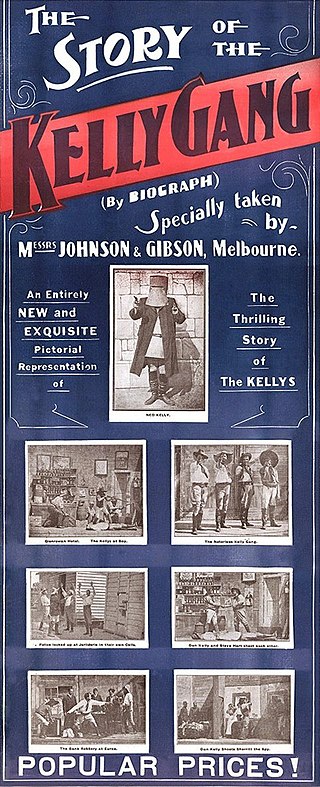
The Story of the Kelly Gang is a 1906 Australian bushranger film that traces the exploits of 19th-century bushranger and outlaw Ned Kelly and his gang. It was directed by Charles Tait and shot in and around the city of Melbourne. The original cut of this silent film ran for more than an hour with a reel length of about 1,200 metres (4,000 ft), making it the longest narrative film yet seen in the world. It premiered at Melbourne's Athenaeum Hall on 26 December 1906 and was first shown in the United Kingdom in January 1908. A commercial and critical success, it is regarded as the origin point of the bushranging drama, a genre that dominated the early years of Australian film production. Since its release, many other films have been made about the Kelly legend.

The Last Continent is a fantasy novel by British writer Terry Pratchett, the twenty-second book in his Discworld series. First published in 1998, it mocks the aspects of time travel such as the grandfather paradox and the Ray Bradbury short story "A Sound of Thunder". It also parodies Australian people and aspects of Australian culture, such as Crocodile Dundee, The Adventures of Priscilla, Queen of the Desert and Mad Max films, the Australian beer XXXX, Vegemite, thongs, cork hats, the Peach Melba, Skippy the Bush Kangaroo, the bushranger Ned Kelly, the Henley-on-Todd Regatta, and the Australian songs "Waltzing Matilda", "Down Under", and "The Man From Snowy River".
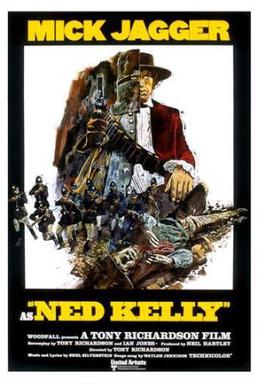
Ned Kelly is a 1970 British-Australian biographical bushranger film. It was the seventh Australian feature film version of the story of 19th-century Australian bushranger Ned Kelly, and is notable for being the first Kelly film to be shot in colour.

Australiana includes the items, people, places, flora, fauna and events of Australian origins. Anything pertaining to Australian culture, society, geography and ecology can fall under the term Australiana, especially if it is endemic to Australia. Australiana often borrows from Australian Aboriginal culture, or the stereotypical Australian culture of the early 1900s.
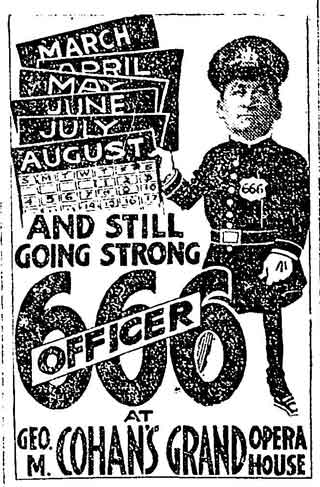
Officer 666 is a 1916 silent film made in Australia, based on a successful Broadway comedy of 1912. The film was directed by Fred Niblo who would go on to direct The Mark of Zorro, The Three Musketeers, Blood and Sand and over forty more films.
The Phantom Stockman is a 1953 Australian western film written and directed by Lee Robinson and starring Chips Rafferty, Victoria Shaw, Max Osbiston and Guy Doleman.
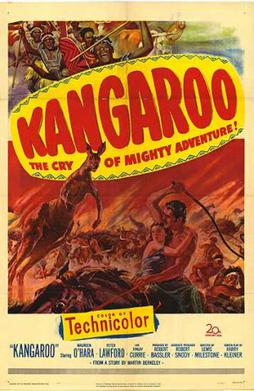
Kangaroo is a 1952 American Western film directed by Lewis Milestone. It was the first Technicolor film filmed on location in Australia. Milestone called it "an underrated picture."
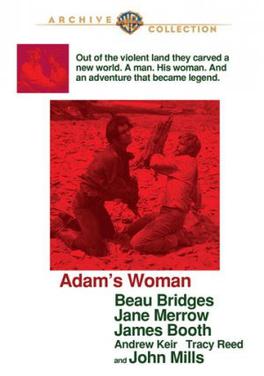
Adam's Woman is a 1970 Australian-American historical drama film directed by Philip Leacock and starring Beau Bridges, Jane Merrow and John Mills. It has been called a "convict Western".
"Moreton Bay" is an Australian folk ballad. It tells of the hardship a convict experienced at penal settlements around Australia, in particular, the penal colony at Moreton Bay, Queensland, which was established to house convicts who had reoffended in settlements in New South Wales. The song references exceptionally brutal treatment of convicts while the colony was under the command of the infamous Patrick Logan. It also describes Logan's death at the hands of local Aborigines and the joy felt by the convicts upon hearing the news. The song may have been composed at the time of Logan's death on or soon after 18 October 1830. A version entitled "The Convict's Arrival" or "The Convict's Lament on the Death of Captain Logan" has been attributed to Francis MacNamara who was transported to Australia in 1832 and was never held at Moreton Bay. It is customarily sung to the tune of the early 19th century Irish ballad "Youghal Harbour", which was used later for the song "Boolavogue", the lyrics of which were written in 1897 for the centenary of the Irish Rebellion of 1798.
Andrew Moore is an Australian historian and academic, a specialist in Australian right-wing politics. He has taught at the University of Sydney, The University of New South Wales, England's University of Lincoln and the University of Western Sydney. His areas of expertise include Twentieth Century Australian History, Irish-Australian history and social history of sport, especially rugby league football. Moore is a leading expert on both the New Guard and the Old Guard.
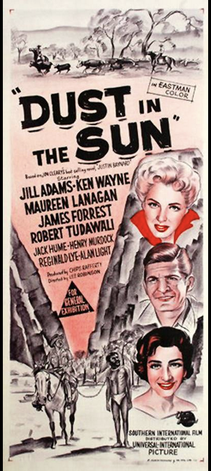
Dust in the Sun is a 1958 Australian mystery film adapted from the 1955 novel Justin Bayard by Jon Cleary and produced by the team of Lee Robinson and Chips Rafferty. The film stars British actress Jill Adams and an Indigenous Australian actor Robert Tudawali as Emu Foot.

The Shadow of Lightning Ridge is a 1920 Australian silent film starring renowned Australian sportsman Snowy Baker. It has been called the most "Western"-like of the films Baker made in Australia.
The bushranger ban was a ban on films about bushrangers that came in effect in Australia in 1911–12. Films about bushrangers had been the most popular genre of local films ever since The Story of the Kelly Gang (1906). Governments were worried about the influence this would have on the population and bans against films depicting bushrangers were introduced in South Australia (1911), New South Wales and Victoria (1912).
Patricia (Trish) Madigan OP is an Australian religious sister, a member of The Dominican Sisters of Eastern Australia and the Solomon Islands and Executive Director of the Dominican Centre for Interfaith Ministry Education and Research (CIMER).
Erin Gabrielle White is a feminist philosopher and theologian. As an author she contributed significantly to feminist scholarship in Australia. She was the founder of the Sydney Women-Church Group and one of the founding editors of Women-Church: an Australian journal of feminist studies in religion.
Bernice Moore is an Australian educator and former Sister of the Good Samaritan from Sydney. She is known for her significant contributions to the fields of education, feminist theology and social justice. Moore was awarded the Medal of the Order of Australia in 1997.
Melissa Brickell is an Indigenous Australian welfare worker based in Melbourne, Australia. She served as Director of Reconciliation Victoria and was the Chairperson for the Stolen Generations Sorry Day Committee and the Stolen Generations Alliance. She also served on the National Aboriginal and Torres Strait Islander Catholic Council and the National Aboriginal and Torres Strait Islander Ecumenical Commission.
Jean Gledhill is a member of the Uniting Church in Australia and a former member of the Commission on the Status of Women of the Australian Council of Churches. She was associated with two publications that contributed to the development of religious feminism in Australia. These were the Christian feminist magazine Magdalene and Women-Church: an Australian journal of feminist studies in religion.
The Bunyip and the Satellite is a 1957 Australian stage musical written by Barry Humphries and Peter O'Saughnessy. It was based on Frank Dalby Davison's children's novel Children of the Dark People.












